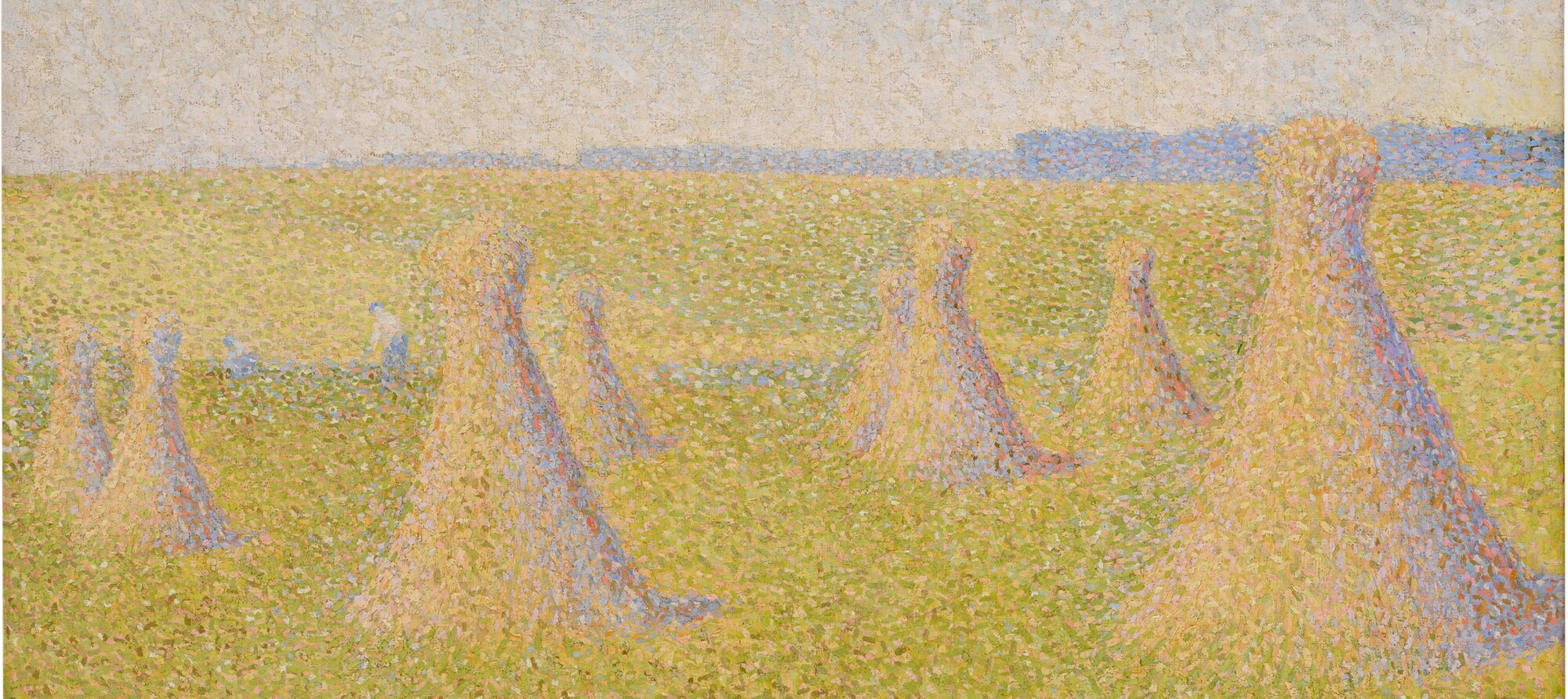We would like to thank Monsieur François Lespinasse for his kind assistance in writing this catalogue note.
I dream of an art that will stay within the realms of sensation – somehow irreducible – in which colors and forms would be functional to the chosen impression
Charles Angrand was born in 1854 in the village of Criquetot-sur-Ouville in the center of Caux, located between the cliffs of the English Channel and the meanders of the Seine. His father, a school teacher in the village since 1849, encouraged Charles to follow his example and become a school teacher, as had his younger siblings Maria and Paul. After primary school, Charles returned to Rouen to the Ecole Normale where he excelled academically. He was named assistant teacher at the Lycée Corneille of Rouen in October of 1873. Fueled by his interest in painting, he enrolled at the Académie de Peinture et de Dessin in Rouen where he was taught by the painter Gustave Morin. Angrand, influenced by the Impressionist movement, chose to begin painting outdoors, en plein air.

In October 1882, Angrand joined the Collège Chaptal at 45 Boulevard des Batignolles. This school, founded in 1844 by Prosper Goubaux, was close to the train station Saint-Lazare at the Place Clichy. Angrand went on to spend fourteen years teaching at the Collège Chaptal, and during each vacation, he traveled to his family’s house in Normandy where he could connect with the beautiful and unspoiled landscape.
He submitted work to the Salon in 1883 and 1884 only to be rejected. He then joined the group Jeunes Artistes, as well as Artistes Indépendants, of which he was a founding member. Through these associations he met Albert Dubois-Pillet, Paul Signac, and the inventor of Divisionism, Georges Seurat. Seurat purchased Angrand’s painting Fleurs des champs (current location unknown) and invited him to his atelier where the he first saw Seurat’s masterpiece Un Dimanche à la Grande Jatte (see fig. 2).
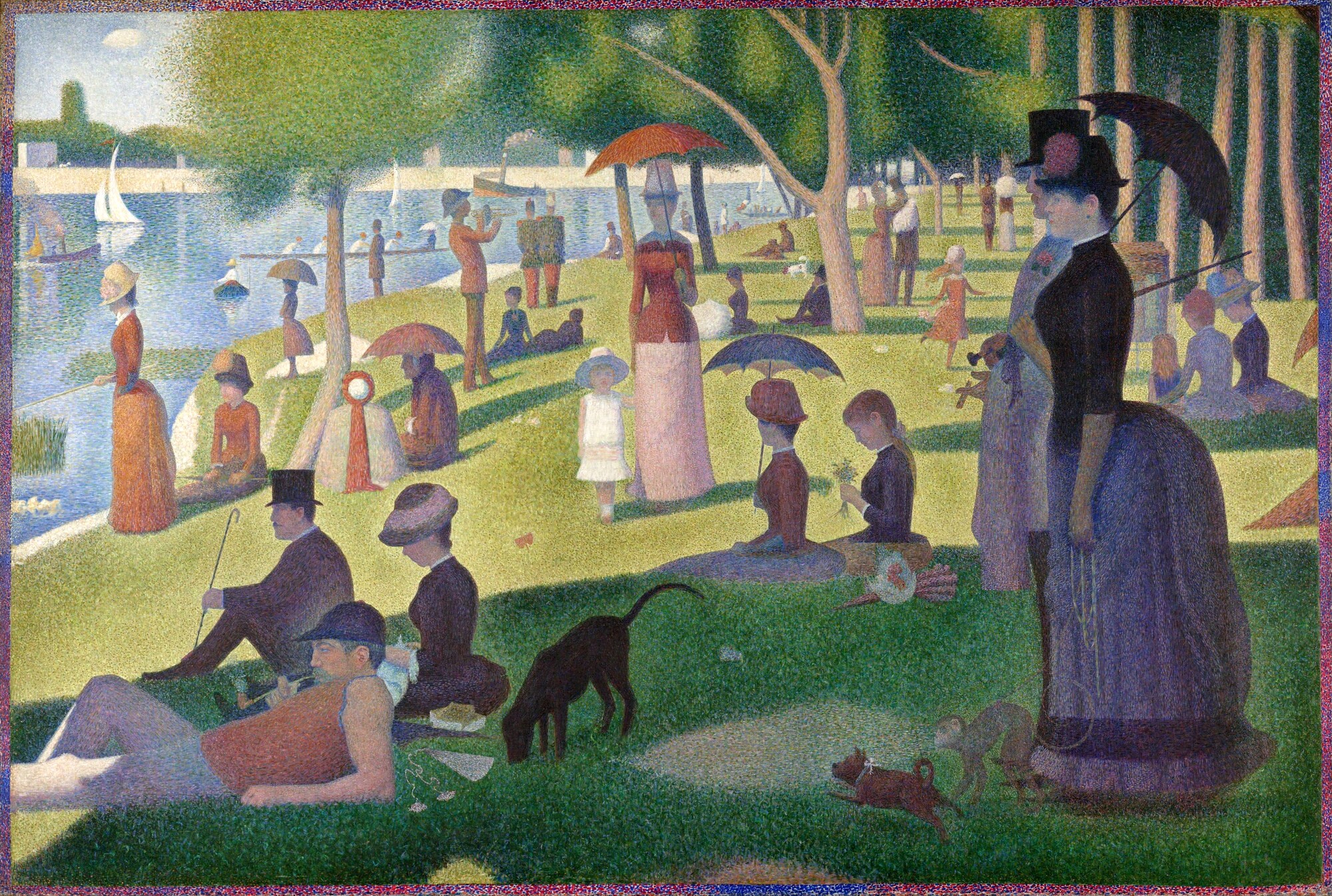
Charles Angrand and Seurat became close friends and colleagues, often meeting at the Café Marengo, and visiting each other’s ateliers. Angrand painted by Seurat’s side on the Grande Jatte and was completely mesmerized by his method. During the summer of 1886 at Criquetot-sur-Ouville, he began a revolutionary work, Coin de ferme, following his friend’s technique. Angrand went on to exhibit this work at the 30th Salon municipal in Rouen, where once again his work received negative reviews by the press. Georges Dubosc, a journalist at Journal de Rouen, was the sole defender of the revolutionary landscape and the only one who recognized the style's innovative genius.
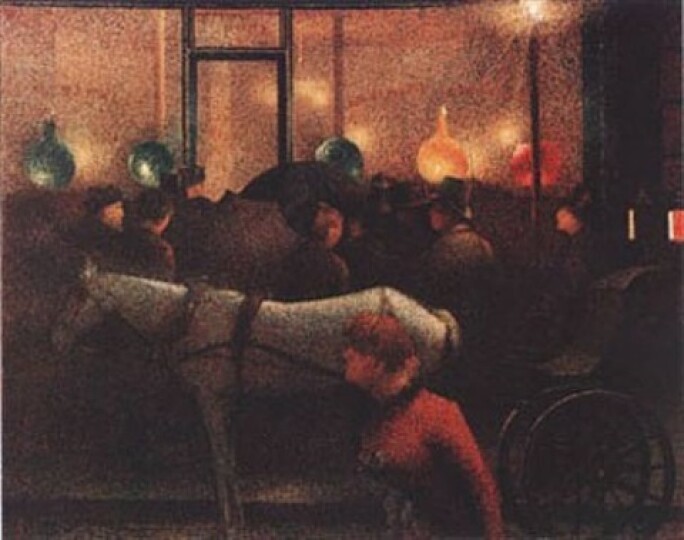
The artist persisted, tuning his Divisonist technique and began painting one of his few urban masterpieces, Un Accident, depicting a suffused evening on the streets of Paris (see fig. 3). During the summer of 1887, he began painting the present work based on the countryside of Criqueot-sur-Ouville, not far from his beloved family home in Normandy.
With a strict remarkably balanced composition animated by two small figures, the present work is divided into three parts: an extended foreground that divides the canvas in two equal parts overlain by a middle section with eight haystacks.
The upper register of the canvas depicts a beautiful placid sky without a single cloud in sight. On the right, an area with somber trees both balances and diminish progressively. The canvas is remarkably organized.
Chromatically speaking, yellow tones dominate, softly shifting towards a serene tender green. The purple shadows on the right of the haystacks create depth to these unusual cone shapes, and the slightly descending perspective allows a subtle median cut to this Normand landscape. The techniques and advice from his friend Georges Seurat are perfectly assimilated, even though the technique is more delicate. Angrand wrote to his friend Charles Frechon (1856-1929) mid December 1887: “…our exhibition project at Petit. The opening is scheduled for the 30th. (…) I am finishing at the moment – Les Moyettes – and Le Dîner – would you allow me to tell you what I think? Obviously right. Well I think that les Moyettes will interest the public. Toutefois elles restent d’une facture bien peinée - et aussi d’une technique indécise (…) If you come to the Indépendants I will grab you by the jacket and force you to recognize the logic and scientifically superiority of our technique…”
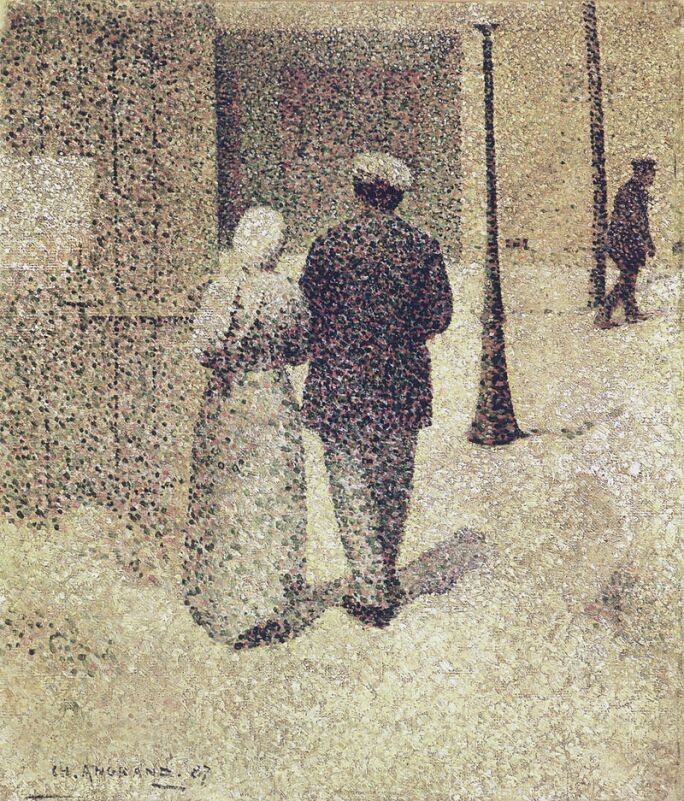
The present work was exhibited at the Galerie Georges Petit in Paris during the Exposition des 33 from late December 1887 to January 1888, in which the artist presented nine paintings. To quote the article by the symbolic poet and critic Gustave Kahn: “The Exposition des 33 is not a theoretical exhibition, a group of artists united in the same style and technique (…) In the new Neo-Impressionist technique, inaugurating a concern for the local values and color, M. Angrand has made great progress; his work 'Les Meules' denotes a large vision of the sun-drenched fields concluding in a horizon which allows us to calculate the languor and slowness of the landscape.”

The canvas went on to be included in the exhibition of Artistes Indépendants in 1888. The work was lauded by the Parisian press and was featured in about fifteen articles, including by Arsène Alexandre in Le Paris, La Plume, and the Revue Moderne. One of these articles from 1888 exclaims “M. Angrand, whose style closely resembles Seurat’s, exhibits three canvases with a general tonality that is a little too purple; his stroke, although harsh, does not lack harmony and his Meules are a good landscape.”
The famed critic Félix Fénéon, the exceptional scrutineer of the Neo-Impressionist movement, exclaimed of the present work in L’Art Moderne de Bruxelles in 1888: “Les Meules one of his most atmospheric landscapes.”
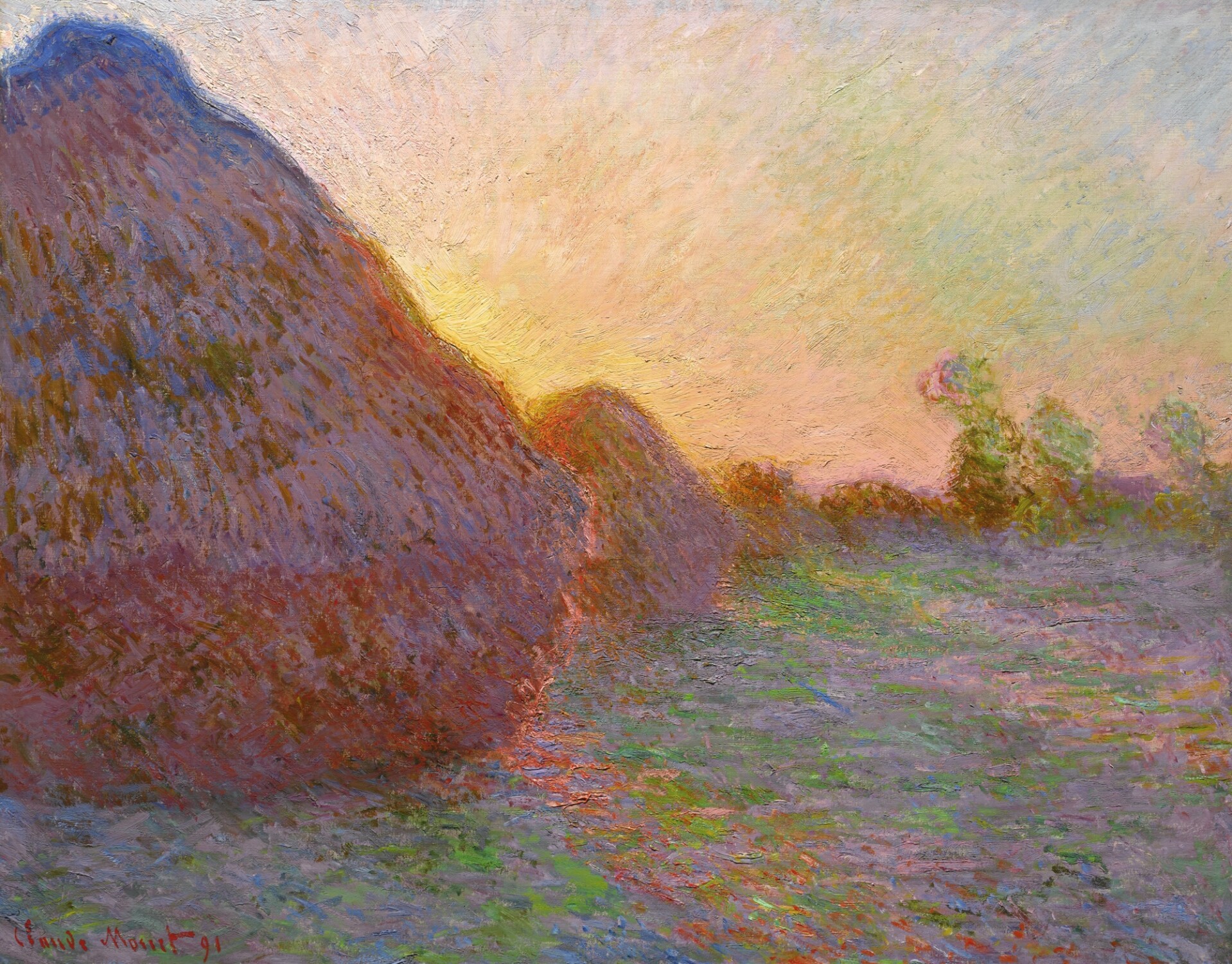
The writer Paul Delesques noted in Le Nouvelliste de Rouen: “It is impossible to deny the feeling of observation, the harmony of the palette, the vibration of the air in the compositions of M. Angrand, and we find these same qualities in [the present work] which he exhibits today, and which are drenched in light and air.”
Georges Dubosc wrote of the present work in Journal de Rouen: “the work stems directly from the art theories from this small school: it is a large, flat and yellow countryside, extending below the limpid air, until a sky cut by a line of haystacks and by the line of tall trees lost in the horizon. To render this simplicity grand, this atmosphere clear and united, vibrant across the fields; to make us feel this impression of warm and calm light extending far, the artist, through design and color, has tried to simplify the effect, to cut back the details that disperse interest, and has tried to not dwell in the particulars of light: he has managed to produce, in a restrictive canvas, an impression of a large space that imposes itself to the most recalcitrant gaze and admiration.”
This technique – superficially denoted as pointillism by numerous critics, is the division of tone – it allows easy and routine application of the physical laws of vision: laws of contrast and reaction; simple question of 'métier', of method, but so important because the intellectual evolution depends on the chromatic sensation
The present work was later featured in the “Concours de la Société des Amis des Arts” at the Musée de Rouen in 1889, as number 5, Les Meules de blé. In a letter to a former schoolmate, Angrand wrote of the exhibition: “ A couple words about my work (...) agree that it is a skillful transition towards blue. I have exhibited in Rouen. Rouen bewildered has opened its mouth, but only that. Not it’s purse! The press has opened its columns to intelligent articles and the incense of a few epithets has reached me. This already exceeded my expectations. This incense was burnt in front of my Meules de blé that you know.” In 1891, the present work was exhibited in Brussels, at the Exposition des XX, eighth exhibition, as number 2.
After the death of Charles Angrand in Rouen in 1926, the painting was exhibited at the Salon du Sud-Est in 1927, and then in 1968 at the The Solomon R. Guggenheim Museum in New York.
It is therefore one of the most important work in the artist’s painted oeuvre, which consists of a small production of around one hundred works.
Exemplars of Pointillism alongside Angrand
